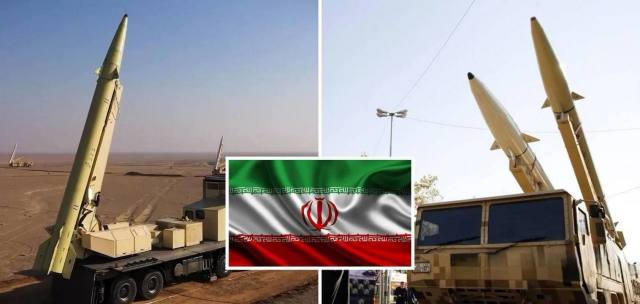Since the topic of Iran's ballistic missiles is quite extensive, we will continue to consider it. Recall that the first part of the material is devoted to a brief history of the formation of the Iranian missile strategy, the second describes the composition of the missile sector in the military-industrial complex of the Islamic Republic of Iran (IRI), the third tells about liquid-fueled ballistic missiles (BR). The following are Iranian solid fuel BRS.
Iran's solid-fuel ballistic missiles
Since solid-fuel BRS have inherent operational and operational advantages over their liquid-fueled counterparts, the appearance of this class of missiles in the arsenal of Iran already during the Iran-Iraq war does not seem to be something special.
In the second half of the 1980s, Iran purchased HQ-2 anti-aircraft missile systems from China, which were the Chinese version of the Soviet S-75 air defense system. His rocket had a mixed-type engine with a solid-fuel first and liquid second stage. Later, after the transfer of documentation to the IRI, its own production of such missiles began. In 1989, Tehran purchased from Beijing a short-range M-7 (CSS-8) with transport-charging machines.
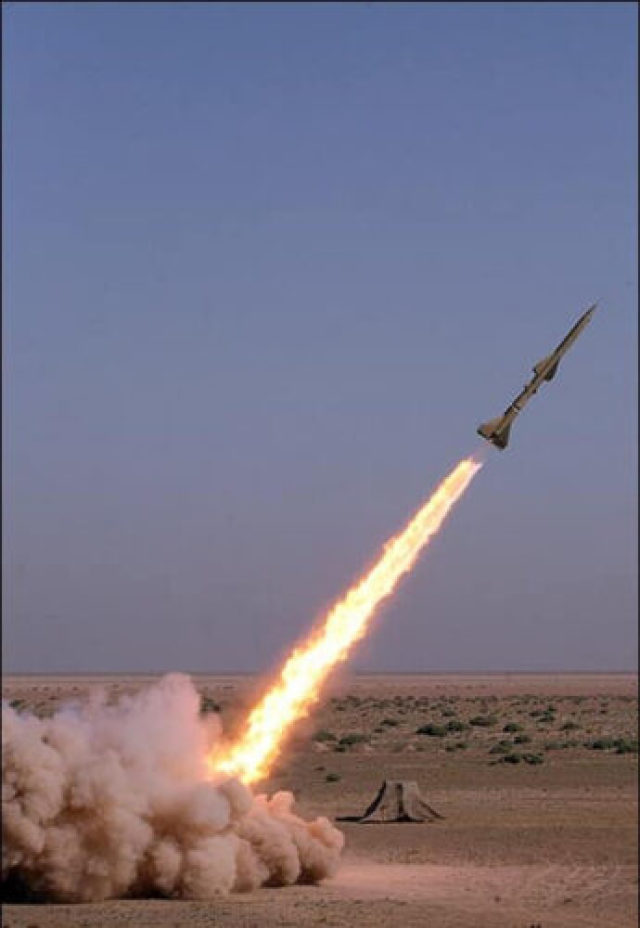
BRMD "Tondar-69"
This tactical missile system was also made on the basis of the HQ-2 SAM, but with an inertial guidance system installed, which made it possible to strike ground targets. The complex, which received the designation "Tondar-69" (Tondar-69) in Iran, entered service with the IRI Armed Forces in 1992, as the first controlled BR partially powered by solid fuel. This mobile system had a firing range of about 150 km, a warhead mass of 190 kg and a calculated circular probable deviation (CVO) of 300 m. Although the characteristics of the Tondar-69 quickly became obsolete, the complex is still used for missile firing during tactical exercises of the ground forces, and its missiles are used as supersonic targets for the preparation of air defense calculations.
After Iraq used Soviet-made Luna solid-fuel missiles with a firing range of up to 70 km at the turn of 1985, work on the production of its own systems with similar characteristics began in Iran. The created Nazeat missiles had a range of up to 130 km. Since in fact they were unmanageable, their QUO reached 500-600 m.
In the 90s, missiles of the Zelzal type were being developed to replace the Nazeat. Work on the project continued for a long time, but it was not possible to achieve high results, primarily due to low accuracy. So, the Zelzal-3 variant, which appeared in 1993, with a starting mass of 3870 kg, could deliver a 900 kg warhead to a range of up to 180 km (a 600 kg warhead to 235 km), but at the same time, the QUOTA was 1000 – 1200 m.
Nevertheless, the experience gained by Iranian engineers during the operation of the Tondar-69, Nazeat and Zelzal formed the basis for the creation of solid-fuel missiles of the Fateh family.
The BR family "Fateh" (Fateh)
The Aerospace Industry Organization of the Iranian Defense Ministry began developing Fateh in 1995, adapting the guidance system of the Tondar-69 anti-ship variant (inertial with active radar) to the modified Zelzal variant. Iranian engineers reduced the mass of the Zelzal warhead by about 100 kg and lengthened the hull. The result, which received the designation "Fateh-110A", could carry a warhead weighing 450 kg at a range of 200-300 km. The first launch was carried out in 2001. Officially, the successful tests of the rocket were announced in August 2002.
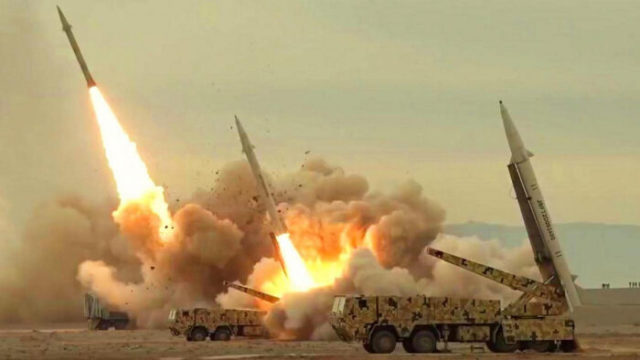
Iran's Fateh-110A ballistic missiles
Since then, the model has undergone several evolutionary changes. In 2004, the Fateh-110V variant appeared with a range of 250 km. The installation of GPS navigation led in 2010 to the modification of "C" with a range of 300 km. The fourth generation (D) allows to deliver a warhead weighing 650 kg at a range of 300 km. At the same time, according to Iranian sources, its advantages include increased accuracy, longer service life of the missile, reduced deployment time, pre-launch tests and preparation for firing. Efforts to improve accuracy include the development of a ground-based positioning system and the use of global positioning systems such as BDS and GLONASS instead of GPS. There are also different types of warheads designed for different purposes. It is reported that in the final section of the trajectory, the warhead develops a speed of up to 1.6 km / s, exceeding the speed of sound by 5 times. The total flight time of the rocket for the maximum range is estimated at about 5 minutes.
"Fateh-313" Tehran presented a new model of the Fateh family in August 2015. It is almost identical to the Fateh-110, except that it uses a lighter composite engine casing, as well as composite fuel, to reduce the rocket's own mass. In combination with a payload reduced by 100 kg (350 kg), the improvements made increased the firing range to 500 km. The rocket also has a more advanced inertial navigation system and some form of guidance on the final section of the trajectory. A new launcher was designed and built for the Fateh-313, which was not previously used for other models of the Fateh family.
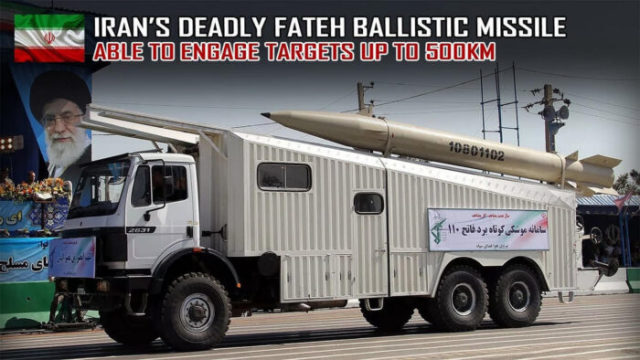
Fateh-313 ballistic missile
"Fateh Mobin" (FatehMobin) The next iteration of the Fateh family of missiles appeared in 2018 under the designation "Fateh Mobin" ("Bright Conqueror"). According to Western sources, the missile has an upgraded guidance kit with an electro-optical homing head (GOS). Iranian experts, on the contrary, claim that a thermal imaging GPS has been installed, which guarantees the accuracy of hitting in all weather conditions, day and night. The mass of the warhead, depending on the source, ranges from 350 to 450-650 kg. The firing range is from 300 to 500 km (moreover, Western experts give a higher indicator), the QUOTA is less than 100 m (the Iranians define this indicator at 5 m). It is important that the Fateh Mobin guidance kit can be installed on other models of this family of solid-fuel ballistic missiles of Iran.
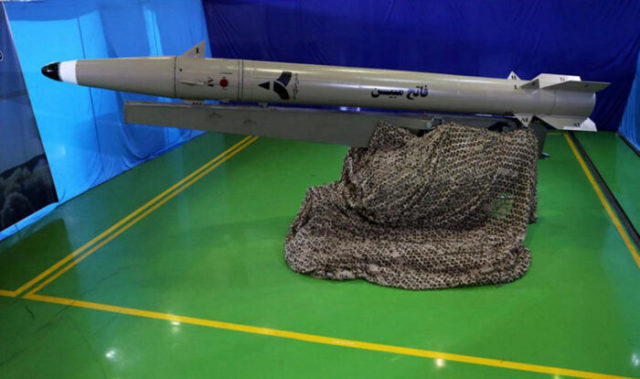
Fateh ballistic missile Mobin"
"Khalije Fars" (Khalij-e Fars)
A separate direction of development of the Fateh family was the solid-fuel anti-ship missile (PKR) "Khalijeh Fars" ("Persian Gulf"). The installation of an optoelectronic guidance system made it possible to attack moving targets (ships) with high accuracy. The rocket was introduced in 2010.
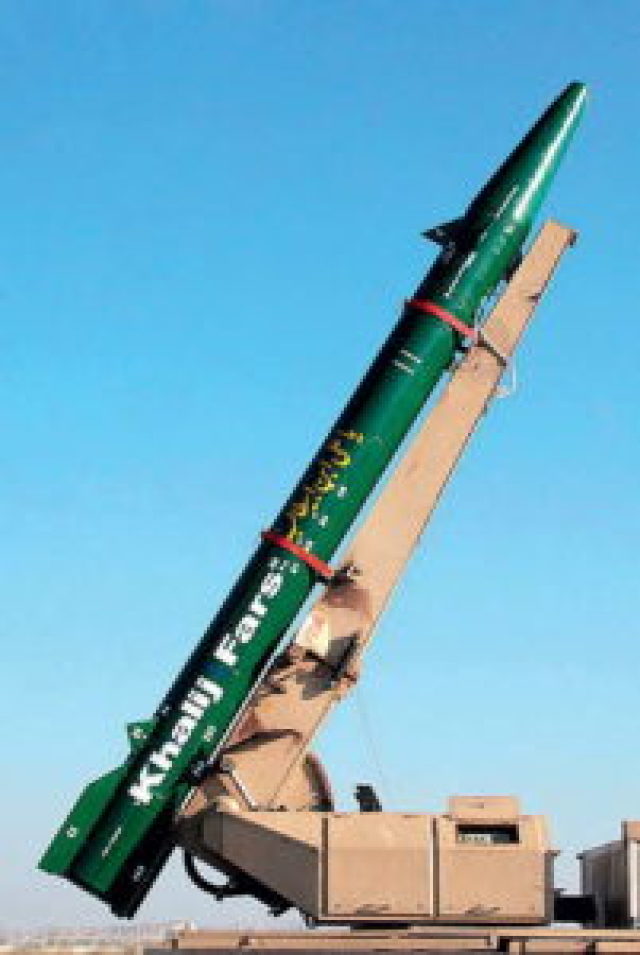
Iran's Khalij Fars anti-ship missile
The firing range of 300 km allows you to control the Persian Gulf and partially the Arabian Sea. Iranian sources pay special attention to the power of the warhead of the missile, claiming that it is equivalent to 7 Mark 82 bombs or 3 Mark 83 bombs (according to American data, the mass of the warhead is equivalent to 450 kg of conventional explosives). Taking into account the high flight speed of the warhead, its impact on the target increases (the missile penetrates the deck of the ship).
The same sources note that the Khalije Fars can carry a separable (cluster) warhead, which is capable of launching up to 3,000 submunitions with variable speeds from 600 to 2000 m/s. Their detonation generates a detonation wave 1.8-2.5 times faster than the speed of sound. The missile status quo declared by the IRGC command is 2 m (IISS experts estimate this figure to be within 100 m).
"Hormuz" (Hormuz)
The next step in the development of Iran's solid-fuel ballistic missiles was the use of passive radar guidance technology to create the first ground-based anti-radar missile. The missile is designed to defeat ground-based stationary and mobile radar systems of combat control and air defense, as well as similar means of the enemy Navy. The PKR of this class received the designation "Ormuz-1". For the first time, the rocket was shown in April 2014 during a demonstration to the Supreme Leader of Iran of the achievements of the aerospace forces of the IRGC.
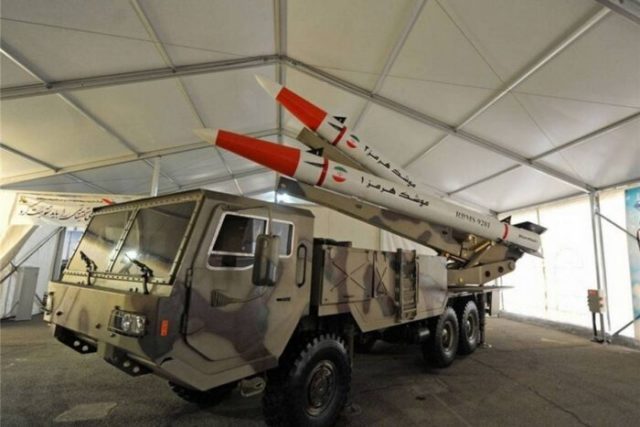
PKR "Ormuz-2"
The successes of Iranian engineers in the field of synthetic aperture radar (SAR) in the millimeter range made it possible to use active radar guidance, which led to the appearance and production of the Ormuz-2 RCC. According to IISS experts, both versions of the missile have a firing range of up to 300 km, a warhead weighing 450 kg and a CVO of less than 100 m. Iranian experts point to the increased capabilities of the warhead "Hormuz-2" to penetrate the hull of the ship and penetrate into the vessel.
"Zulfiqar" (Zulfiqar)
Iran presented the next single-stage solid-fuel version of the Fateh family under the designation Zulfakar on September 25, 2016. In relation to the Fateh type, the rocket has a slightly larger diameter of 680 mm and a length of 10.3 m. The increased size allows delivering 350 kg (according to Iranian sources 579 kg) of payload at a range of up to 700 km, which is 200 km more than the Fateh-313. In addition, it is believed that Zulfikar has a guidance package that uses commercial global navigation satellite systems, which makes it very accurate. Another feature of the design is the transition from a pointed to a more blunt shape of the nose. An increase in the curvature of the tip of the nose is used at hypersonic speeds (more than MACH 5) to reduce the heat generated and less transfer it to the rocket.
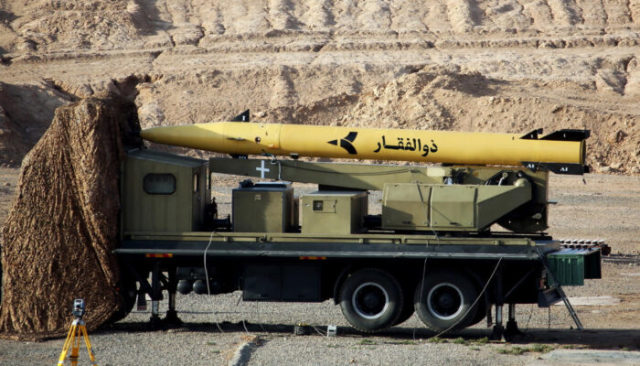
Iran's Zulfikar ballistic missile
As part of Operation Leylat al-Qadr, on June 18, 2017, the IRGC launched 6 Zulfikar missiles at IG targets (a terrorist organization banned in the Russian Federation) in the province of Deir ez-Zor, in Syria. The missiles launched from bases in the western provinces of Kermanshah and Kurdistan and traveled more than 600 km before hitting their targets. Subsequent analysis of images from open sources allowed experts to determine the launch point at a missile base 15 km northeast of Kermanshah.
Once again, Zulfikar missiles were used on October 1, 2018. The operation was called "Muharram Strike". From western Iran, the AKC IRGC fired 6 BR at IG targets in Al-Bukamal, on the eastern border of Syria with Iraq (range 570 km). The strike was Iran's response to a terrorist attack a week earlier at a military parade in Ahvaz, which killed 25 people. Of the six BRS in the salvo, four were solid-fuel Zulfikar, the other two were liquid–fueled BRS. Immediately after the missile strike, the IRGC attacked the positions of the terrorists with seven strike drones.
However, it was the missile strike in January 2020 on the Ain al-Assad airbase in Iraq that demonstrated Iran's mastery of precision guidance technologies for short-range systems. Similar to the June 2017 strike, the January 2020 attack used Zulfikar missiles, apparently launched from the same missile base outside Kermanshah. (The salvo also included Kiam missiles and possibly other Fateh missiles). It is claimed that most of the missiles used in the attack hit the designated targets.
In September 2020, Iran for the first time introduced the ZulfiqarBasir, a naval version of the Zulfiqar with an optoelectronic GPS.
"Dezful" (Dezful)
According to IISS analysts, "Dezful" is a continuation of the "Zulfikar" model. The rocket was presented on February 7, 2019 as the newest product of the Iranian missile industry.
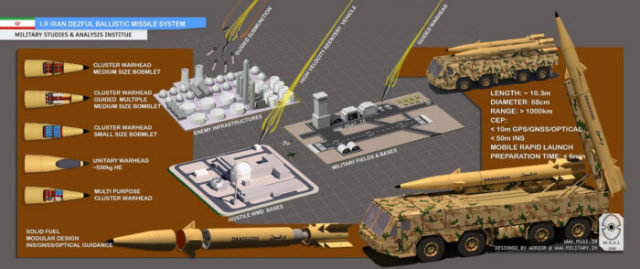
Dezful missile system
Like its predecessor, Dezful has a diameter of 680 mm, a length of 10.3 m and a lightweight composite body. During the presentation, the commander of the AKC IRGC A. Hajizade said that the firing range of the "Dezful" reaches 1000 km, in addition, the power of the warhead is twice as large as that of the "Zulfikar" (presumably the "Dezful" carries a different type of warhead). At the same time, it is noted that the external dimensions and shape of both types of BR seem to be the same. Like the "Zulfikar", the "Dezful" has a blunt shape of the tip of the head part. The speed of the warhead is higher and reaches MACH 9 (according to Iranian sources). The warhead "Dezful" has high maneuverability and is capable of carrying false targets. Another feature of the design is a special type of paint used to cover the rocket body. It is noted that the color of the hull (gray) coincides with the color of modern fighters, which probably indicates the presence of radio-absorbing properties.
Given the same size of the "Dezful" and "Zulfikar", there is a high probability that the "Dezful" can be launched from paired launchers (PU) developed for the predecessor. According to A. Hajizade, it takes 6-8 minutes to prepare the rocket for launch. The estimated range of 1000 km allows the "Dezful" to reach the city of Haifa in Israel, and in the case of a launch from the western regions of Iran and with an increase in the range to 1118 km – to keep the entire territory of Israel under threat.
In February 2020, Iran introduced the Raad-500 BRMD (Raad-500), which uses a carbon composite body, which reduces weight and provides a firing range of up to 500 km. Although its characteristics are similar to the earlier Fateh-313 model, the Raad-500 has other control surfaces and a slightly different shape of the nose, which indicates a further improvement in controllability.
"Shahid Hajj Qasem" (Shahid Hajj Qasem)
Iran's medium–range ballistic missile "Shahid Hajj Qasem" is one of the latest products of the Iranian missile industry. The model was first introduced in August 2020. The missile is named after the commander of the IRGC's Al-Quds forces, General Qasem Suleimani, who died in January 2020.
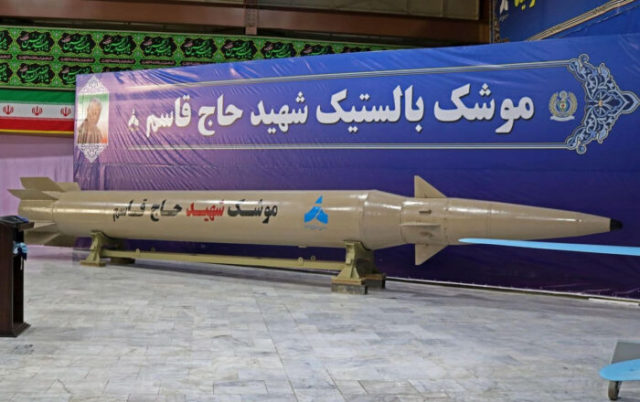
Iran's BRSD "Shahid Hajj Qasem"
Externally, the rocket is similar to the Zulfikar, but has a larger diameter (according to various estimates, from 880 to 1000 mm). During the presentation, the Fars News agency stated that the Hajj Qasem has a firing range of up to 1400 km. The probable mass of the warhead (again, according to various sources) ranges from 350 kg to 1000 kg. Moreover, it is claimed that it uses a new explosive substance (BB) of increased power. The missile guidance system includes an inertial unit and a receiver of signals from global navigation systems. There is a high probability of having its own warhead guidance system on the final section of the trajectory. The flight speed of "Hajj Kasem" is more than 7 MACH and increases when diving at the target. Independent estimates give the indicator of the QUO = 3 m.
"Sajil" (Sajil)
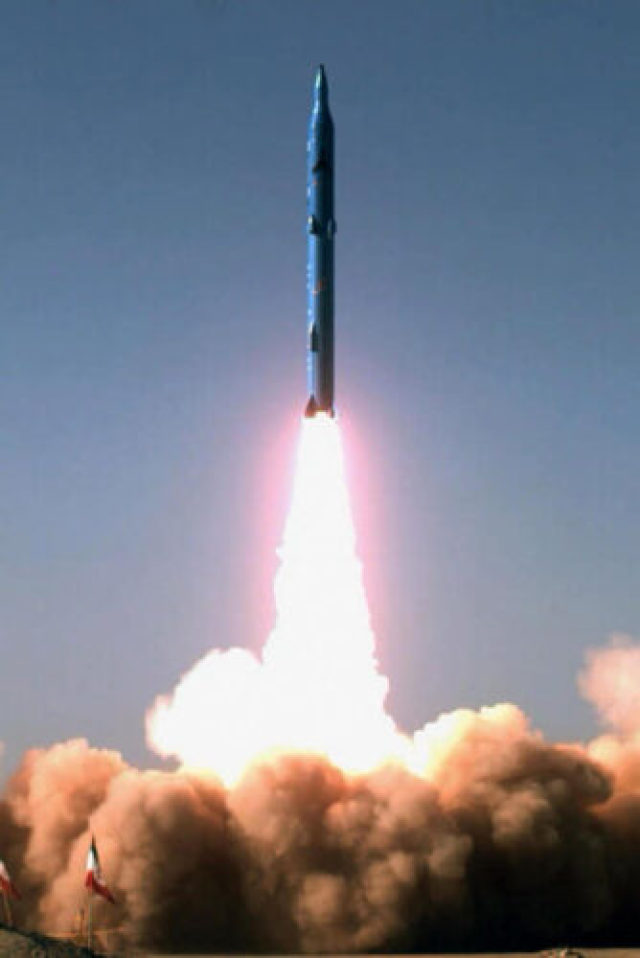
Launch of the Sajil BRSD
A demonstration of the test launch of the two-stage solid-fuel BRSD "Sajil" was broadcast on Iranian television in November 2008. The video recording included a successful start, but the video ended before the second stage was triggered. Over the next year, three more launches followed, but already the Sajil-2 products. Since the external features of the two variants looked identical, the question arose about the reasons for the name change. Perhaps this reflected the introduction of small changes to the key components of the rocket, or was a symbolic gesture indicating the transition to the second phase of the development program. According to the report of the UN panel of experts, Iran conducted two more unannounced flight tests of the Sajil in 2010 and 2011.
The Sajil BRSD has a diameter of 1.25 m and a length of 18 m. It is estimated that it is capable of carrying a 700 kg warhead at a range of up to 2000 km. Since its dimensions are similar to the dimensions of the Gadr-1 liquid–propellant BRSD, both models can have a common mobile PU, as well as a common warhead. For unclear reasons, at the beginning of 2011, Tehran took a break from testing the missile. However, after almost a decade of inactivity, Sajil reappeared in January 2021, starting during the military exercises "The Great Prophet 15".
Flight tests conducted to date show that an improved version of the guidance system used on the Gadr-1 is probably installed on the rocket. The missile is controlled and effectively controlled using jet blades, which suggests that Iran has managed to replace the fragile graphite blades of the Gadr-1 with a more durable material.
According to experts, the status of the Sajil deployment is still unknown. Obviously, further flight tests will be required before the product is considered reliable and meets traditional standards.
To be continued…
Based on the materials of the resources: iiss.org, missilethreat.csis.org, iranprimer.usip.org
